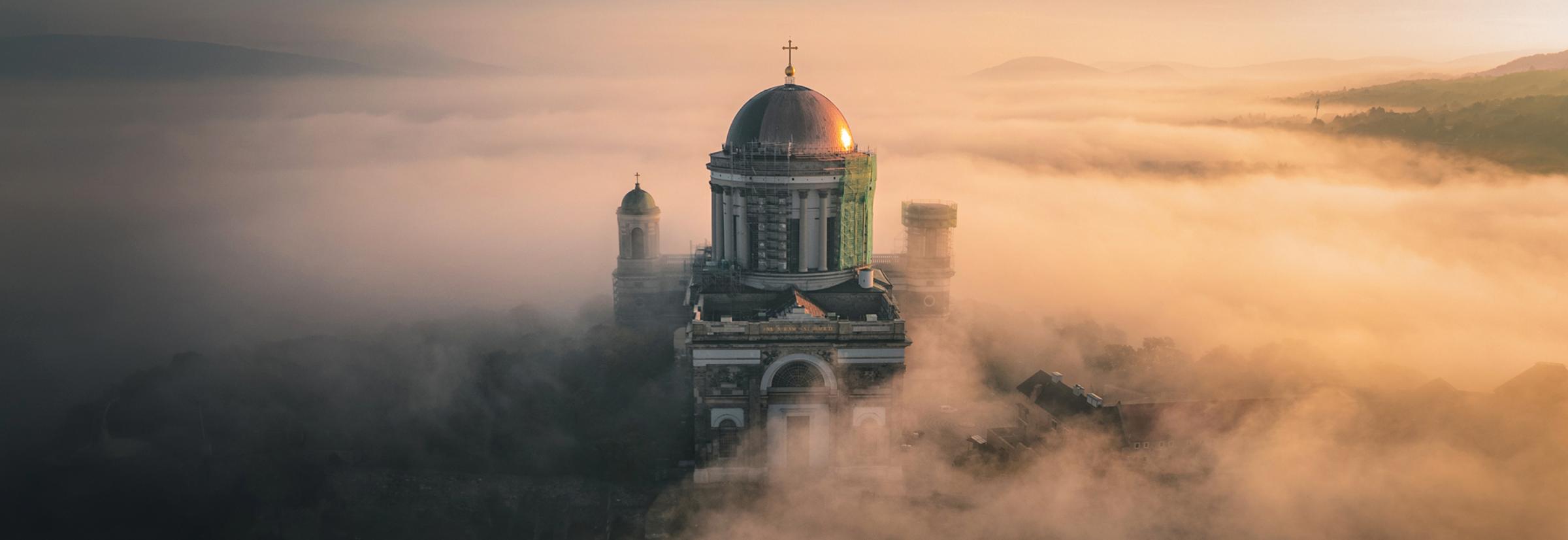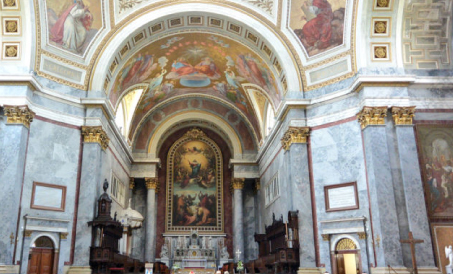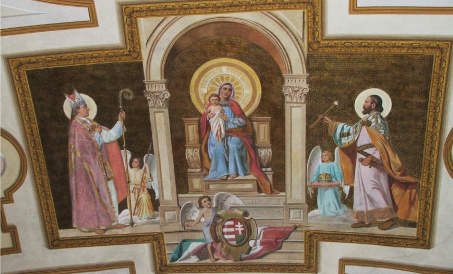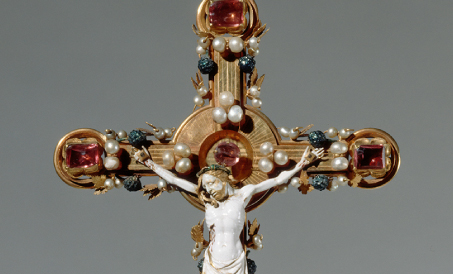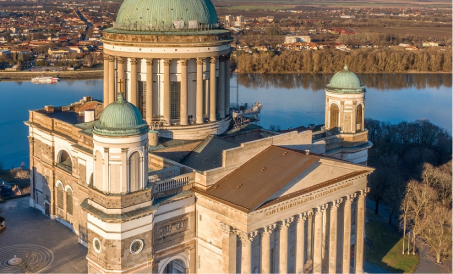† The oldest object in the Treasury is an oval-shaped cut rock crystal. It was made around 870 in Metz,
so it is more than 1145 years old!
† The youngest object in the Treasury is the chalice which was donated to the Esztergom Treasury by Pope
John Paul II in 1991.
† During the construction of the Basilica, builders dug down as far as the bedrock in the Castle Hill to ensure
the stability of the building. The walls in the crypt supporting the dome are 17 metres thick!
† The oldest liturgical textile of the Treasury is the Anjou drapery, made around 1370. It was used as an altar
frontal.
† The largest bell in the Basilica weighs 5827 kilograms. It is about the same weight as a female African
elephant.
† The height of the Basilica is 100 metres. This means that it would take 18 giraffes standing one on top of
another to reach the top of the building.
† The Treasury holds the most objects which were used in the coronation ceremonies of Hungarian kings.
† The fabric of the velvet vestments exhibited in the Treasury is made of silk threads as thin as a human
hair. The silk thread is the product of the pupa, which is a natural phase of development in the silkworm’s
life. In this phase the silkworm, which feeds exclusively on the leaves of the mulberry tree for about six
weeks, encloses itself in a cocoon, a hard covering spun of silk thread, for two weeks. About 800 - 1000
metres of raw silk can be wound off from each cocoon. Both raw and refined silk thread are used for silk
weaving.
† The preparation of the colourful vestments started with the dying of the silk thread. The secret and the
recipe of silk dying was strictly guarded by every Italian city state. In Florence at the end of the 15th
century, the colour crimson made from the dye of the cochineal insect and dyed at least twice in a dyebath,
the special verdebruno colour (greenish-brown) and the so-called alessandrino, a powerful purple made
from mixing red and blue belonged to the most expensive colours.
† Velvet is a special variety of silk fabrics where a metal rod or wire is inserted over the woof threads. When
the fabric is woven, the warp thread forms loops (‘piles’) over the inserted rods. Velvet or ‘cut pile’ is made
by cutting the loop ends, loop pile is made by leaving them as they are.
† In special cases, the dyed velvet was interwoven with gold threads. The Treasury has several vestments,
whose beautiful velvet was made even more ornate by loops formed of gold threads. The most outstanding
of these are the Chasuble of Fojnica, the Chasuble Matthias Corvinus and the so-called Chasuble Báthory a
large area of which is covered in loops made of gold or gilded silver threads.
† Several technical innovations were applied for the construction of the Basilica. For example, hollow bricks
were used here for the first time in Hungary.
† The first of the Basilica’s statues were put in their place in 1831 (the statue of Saint Stephen the Martyr and
the tomb of Ambrus Károly) and the last in 1915 (the statue of the Martyrs of Kassa).
† The crypt and the Chapel of Saint Stephen were the first parts of the Basilica to be finished, in 1831, and the
south tower and the portico the last, in 1869.
† The building of the Basilica took 47 years. The foundation stone was laid in 1822 and the keystone in 1869.
† If we counted all statues and reliefs adorning the interior space of the Basilica, we would find angels in the
highest number - there are 16 of them only at the organ.
† The name and the length of the Basilica of Esztergom are engraved in the floor of Saint Peter’s Cathedral in
Rome as BASILICA CATHEDRALIS ESZTERGOM, between the names of the Cathedral of Ferrara and the
Church of Saint Justine in Padua.
† The interior of the Basilica contains the Bakócz Chapel, built in the 16th century. The chapel was placed to
its present location in a brilliantly executed operation: it was sawn to 1600 pieces under the direction of
master builder János Packh, then reassembled in its new location like a huge jigsaw puzzle and it became
the left-hand side chapel of the Basilica.
† The so-called Chasuble of Fojnica was the throne drapery of King Matthias in its original shape. Its pair is
exhibited in its original form in the Hungarian National Museum.
† It took the dedicated efforts of four Archbishops to build the Basilica. Their coats of arms can be seen in
the portico. The inscriptions under the coats of arms tell us about their respective roles in the phases of the
construction:
Sándor Rudnay - coepit - started
József Kopácsy - continuavit - continued
János Scitovszky - consecravit - consecrated
János Simor - consummavit - completed.
† Several artworks of the Treasury used to be the property of the Royal Treasury and they were probably
handed over to the Archbishop of Esztergom by donation. That is how, among other things, the Matthias
Calvary, the larger and the smaller drinking horns of King Sigismund, the drinking horn Corvinus, the
Chasuble of Fojnica, the small rock crystal salt cellar, later converted into a relic holder, came into the
possession of the Treasury.
† Every square decimetre of the ornamental crosses fixed on the chasubles contains 8 -10 kinds of
embroidery.
† In the eyes of mediaeval people not only gold, silver and gems were the basic materials of treasure,
of precious craftsmanship, but all natural substances whose beauty, colour or peculiarity stood out.
Such materials were used for the beautiful carving of mother-of-pearl, depicting the death of Mary
and the amber pendant with the depiction of the crucified Christ. Both objects are exhibited in the
Cathedral Treasury.
† According to the original plans, the Basilica and the adjoining buildings were to have taken up the whole
Castle Hill. If you visit the Panorama Hall on the second floor, you can see the large model based on the
plans of the whole building complex there
